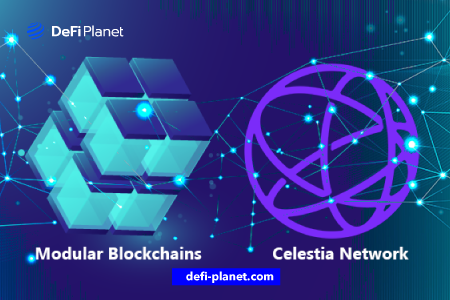Conventional blockchains are intended to enable developers to create decentralized apps and deploy smart contracts on the network. Most traditional blockchains may not allow developers to build their blockchains on the network. This means that if a company wants to build a blockchain, they must start from scratch.
Most blockchain architectures allow developers only to deploy smart contracts, not new blockchains. As the demand for blockchain technology increases, there is a greater need for a framework that will allow businesses to launch customized blockchains without having to build them from the ground up.
The Celestia Network appears to be redefining this standard with its modular blockchain network. This article examines the Celestia Network, its features, and architecture.
What is Celestia Network?
The Celestia Network is a modular consensus and data blockchain network that enables developers to create their own blockchain and deploy it on the network without incurring enormous costs. It functions as a data layer, enabling anyone to deploy and customize their blockchain. Celestia is similar to Amazon Web Services (AWS) in that it allows users to deploy their websites on physical servers.
The Celestia Network was initially known as LazyLedger. Celestia was founded by Mustafa Al-Bassam, a prominent hacktivist and developer currently serving as the company’s CEO. Bassam holds a Ph.D. in blockchain scaling from UCL and is also the co-founder of Chainspace, which was acquired by Facebook.
What are Celestia Network’s Features?
Celestia Network incorporates some features that may double as its advantages.
Blockchain deployment
Celestia Network’s architecture enables developers to deploy customized blockchains to meet their specific requirements. Instead of starting from scratch, developers can save time, effort, and money by launching their blockchain with minimal overhead. According to Celestia’s website, developers can “deploy a blockchain as easily as a smart contract.”
Consensus and security features
Developers can choose to customize the blockchains they deploy on the Celestia network and incorporate a consensus mechanism. They can also choose to use the consensus and security features offered by Celestia. According to their website, the network provides “consensus and security on-demand, enabling anyone to deploy a blockchain without the overhead of bootstrapping a new consensus network.”
Execution environment
Celestia operates an ecosystem that allows developers to customize their blockchain as much as they deem fit. As a result of this, the network does not require users to utilize a specific execution logic. Developers can opt for their own execution logic and design an environment that works for them. They support all types of rollups, but their architecture is primarily built on the EVM and Cosmos SDK.
Scalability
Some existing blockchains, such as Ethereum, are plagued by a lack of scalability. This is reflected in the high transaction cost and slow transaction speed. Scalability is one of the elements of the blockchain trilemma that new generation chains like Celestia Network are trying to solve.
Scalability is a key component of this trilemma that is missing in older blockchains. If a network does not scale with the number of users, it may experience network congestion.
To combat this, the Celestia network does not validate transactions that occur on the chains built on it, meaning that users do not have to worry about slow throughput as in older blockchains.
Different networks have different elements that they use to ensure scalability. Some use sharding, such as the proposed Ethereum 2.0, whereas Celestia employs the data availability sampling method.
Scalability is achieved through the use of rollups, which allows transactions to be executed off-chain. When developers create their chain on Celestia, they can incorporate rollups to execute transactions outside the network while using the ecosystem for consensus.
There are different types of rollups, such as optimistic rollups and zero-knowledge rollups. Zero-knowledge rollups use zero-knowledge proof to demonstrate that something is true without revealing too much about it.
The second type of rollup is an optimistic rollup, which works based on the assumption that every piece of rolled-up data is valid, ensuring that no one tries to game the system.
What is Modular Architecture?
A traditional blockchain is monolithic, which means that the execution layer, settlement layer, and data availability layer are all included in the base architecture. The execution layer is where the decentralized apps created by developers live; the settlement layer is responsible for verifying transactions and security, while the data availability layer manages the history of transactions that occur on the network. Because the base architecture caters to every layer, it can negatively affect throughput.
In the case of a modular architecture, the layers mentioned above are not resident in the base framework of the chain. The base consensus layer in a modular architecture does not cater to settlement and execution but focuses only on data availability. In a modular platform, the settlement layer is independent of the base and execution layers.
The Celestia Network’s Architecture Explained
Celestia network utilizes a modular architecture, which allows developers to customize their execution environment. As a result of its architecture, alterations can be made without having to initiate a hard fork. It is a modular consensus and data network that functions as a minimal chain that does not execute transactions but publishes them in the record.
The architecture differs from the monolithic structure that traditional chains use. Developers who build on a monolithic framework must use a predefined set of programming languages. This architecture does not allow for customization, and the only way to update the chain’s code is through hard forks.
Celestia network has a modular architecture that allows developers to design their execution environments, which can be compared to virtual machines.
Developers can modify their customized blockchains with a modular structure without conducting a hard fork. Celestia serves as the Data Availability layer, catering to the data stored on the network.
Celestia’s Settlement Layer
The settlement layer in the Celestia Ecosystem is built with CEVMOS, which is an acronym for Celestia EVMOS.
According to the founder of Celestia, EVMOS is a “Cosmos SDK chain with the EVM built in,” while CEVMOS is an EVMOS-based chain that was created as a Celestia rollup through Optimint 59 and not Tendermint.
Mustafa Al-Bassam added, “Optimint is a drop-in replacement for Tendermint BFT that enables developers to deploy new chains that use an existing consensus and data availability layer such as Celestia, therefore making the new chain a rollup.”
Those rollups can work on CEVMOS, which is the settlement layer. Ultimately, CEVMOS transmits the data to the Data Availability Layer on Celestia.
Celestia’s Data Availability Layer
Typically, the settlement layer sends data to the data availability layer. The data availability layer nodes are in charge of keeping the data in the same form in which it was received. Since the data availability layer is separate from others, Celestia functions effectively by taking the data created in the chain and storing it in the block. Different blockchains built on Celestia can interact with one another without the fear of data manipulation.
Vitalik Buterin has expressed strong opposition to the concept of cross-chain bridges because of their inherent security risks. Buterin believes that cross-chain bridges increase the risks associated with asset transfers. It is easier for assets to be stolen when they are sent through bridges. The co-founder of Ethereum predicts that the “future will be multi-chain.”
“The fundamental security limits of bridges are actually a key reason why I am optimistic about a multi-chain blockchain ecosystem… I am pessimistic about cross-chain applications.”
Buterin gave an example to buttress his dislike for cross-chain bridges by stating, “You move 100 ETH onto a bridge on Solana to get 100 Solana-WETH, and then Ethereum gets 51% attacked. The attacker deposited a bunch of their own ETH into Solana-WETH and then reverted that transaction on the Ethereum side as soon as the Solana side confirmed it”
“The Solana-WETH contract is now no longer fully backed, and perhaps your 100 Solana-WETH is now only worth 60 ETH. Even if there’s a perfect ZK-SNARK-based bridge that fully validates consensus, it’s still vulnerable to theft through 51% attacks like this. For this reason, it’s always safer to hold Ethereum-native assets on Ethereum or Solana-native assets on Solana than it is to hold Ethereum-native assets on Solana or Solana-native assets on Ethereum.”
In Celestia’s case, bridges connecting one chain to the other on the network will derive their state data from Celestia instead of the individual chains. This is because Celestia is fed with data from both chains, and when bridges depend on the Data Availability Layer, the risk of being misled is reduced.
In Conclusion,
- Celestia Network is a modular consensus and data blockchain network designed to allow developers to build their own blockchain and deploy it on the network without spending much money.
- Celestia operates an ecosystem that enables developers to customize their blockchain to their liking. As a result of this, the network does not require users to utilize a specific execution logic.
- In the Celestia Ecosystem, the settlement layer is created with CEVMOS, which is an acronym for Celestia EVMOS.
- The settlement layer transmits data to the data availability layer.
- Bridges on the network that connect one chain to another will receive their state data from Celestia rather than the individual chains.
If you would like to read more articles like this, visit DeFi Planet and follow us on Twitter, LinkedIn, Facebook, and Instagram.
“Take control of your crypto portfolio with MARKETS PRO, DeFi Planet’s suite of analytics tools.”





















